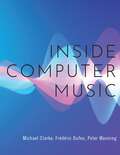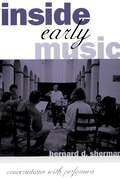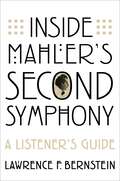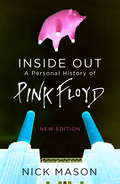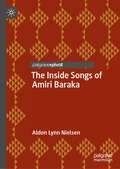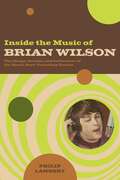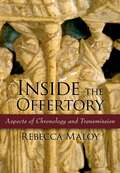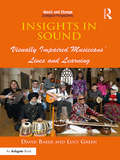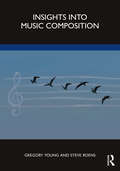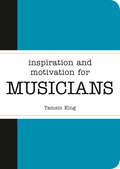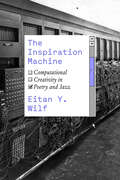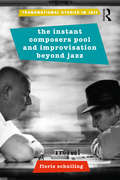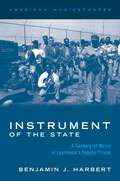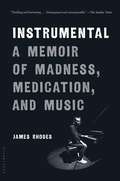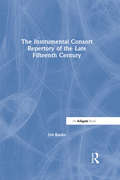- Table View
- List View
Inside Computer Music
by Michael Clarke Frédéric Dufeu Peter ManningInside Computer Music is an investigation of how new technological developments have influenced the creative possibilities of composers of computer music in the last 50 years. This book combines detailed research into the development of computer music techniques with nine case studies that analyze key works in the musical and technical development of computer music. The book's companion website offers demonstration videos of the techniques used and downloadable software. There, readers can view interviews and test emulations of the software used by the composers for themselves. The software also presents musical analyses of each of the nine case studies to enable readers to engage with the musical structure aurally and interactively.
INSIDE COMPUTER MUSIC C
by Michael Clarke Peter Manning Frédéric DufeuInside Computer Music is an investigation of how new technological developments have influenced the creative possibilities of composers of computer music in the last 50 years. This book combines detailed research into the development of computer music techniques with nine case studies that analyze key works in the musical and technical development of computer music. The book's companion website offers demonstration videos of the techniques used and downloadable software. There, readers can view interviews and test emulations of the software used by the composers for themselves. The software also presents musical analyses of each of the nine case studies to enable readers to engage with the musical structure aurally and interactively.
Inside Early Music: Conversations with Performers
by Bernard D. ShermanThe attempt to play music with the styles and instruments of its era--commonly referred to as the early music movement--has become immensely popular in recent years. For instance, Billboard's "Top Classical Albums" of 1993 and 1994 featured Anonymous 4, who sing medieval music, and the best-selling Beethoven recording of 1995 was a period-instruments symphony cycle led by John Eliot Gardiner, who is Deutsche Grammophon's top-selling living conductor. But the movement has generated as much controversy as it has best-selling records, not only about the merits of its results, but also about the validity of its approach. To what degree can we recreate long-lost performing styles? How important are historical period instruments for the performance of a piece? Why should musicians bother with historical information? Are they sacrificing art to scholarship? Now, in Inside Early Music, Bernard D. Sherman has invited many of the leading practitioners to speak out about their passion for early music--why they are attracted to this movement and how it shapes their work. Readers listen in on conversations with conductors Gardiner, William Christie, and Roger Norrington, Peter Phillips of the Tallis Scholars, vocalists Susan Hellauer of Anonymous 4, forte pianist Robert Levin, cellist Anner Bylsma, and many other leading artists. The book is divided into musical eras--Medieval, Renaissance, Baroque, and Classic and Romantic--with each interview focusing on particular composers or styles, touching on heated topics such as the debate over what is "authentic," the value of playing on period instruments, and how to interpret the composer's intentions. Whether debating how to perform Monteverdi's madrigals or comparing Andrew Lawrence-King's Renaissance harp playing to jazz, the performers convey not only a devotion to the spirit of period performance, but the joy of discovery as they struggle to bring the music most truthfully to life. Spurred on by Sherman's probing questions and immense knowledge of the subject, these conversations movingly document the aspirations, growing pains, and emerging maturity of the most exciting movement in contemporary classical performance, allowing each artist's personality and love for his or her craft to shine through. From medieval plainchant to Brahms' orchestral works, Inside Early Music takes readers-whether enthusiasts or detractors-behind the scenes to provide a masterful portrait of early music's controversies, challenges, and rewards.
Inside Early Music: Conversations with Performers
by Bernard D. ShermanThe attempt to play music with the styles and instruments of its era--commonly referred to as the early music movement--has become immensely popular in recent years. For instance, Billboard's "Top Classical Albums" of 1993 and 1994 featured Anonymous 4, who sing medieval music, and the best-selling Beethoven recording of 1995 was a period-instruments symphony cycle led by John Eliot Gardiner, who is Deutsche Grammophon's top-selling living conductor. But the movement has generated as much controversy as it has best-selling records, not only about the merits of its results, but also about the validity of its approach. To what degree can we recreate long-lost performing styles? How important are historical period instruments for the performance of a piece? Why should musicians bother with historical information? Are they sacrificing art to scholarship? Now, in Inside Early Music, Bernard D. Sherman has invited many of the leading practitioners to speak out about their passion for early music--why they are attracted to this movement and how it shapes their work. Readers listen in on conversations with conductors Gardiner, William Christie, and Roger Norrington, Peter Phillips of the Tallis Scholars, vocalists Susan Hellauer of Anonymous 4, forte pianist Robert Levin, cellist Anner Bylsma, and many other leading artists. The book is divided into musical eras--Medieval, Renaissance, Baroque, and Classic and Romantic--with each interview focusing on particular composers or styles, touching on heated topics such as the debate over what is "authentic," the value of playing on period instruments, and how to interpret the composer's intentions. Whether debating how to perform Monteverdi's madrigals or comparing Andrew Lawrence-King's Renaissance harp playing to jazz, the performers convey not only a devotion to the spirit of period performance, but the joy of discovery as they struggle to bring the music most truthfully to life. Spurred on by Sherman's probing questions and immense knowledge of the subject, these conversations movingly document the aspirations, growing pains, and emerging maturity of the most exciting movement in contemporary classical performance, allowing each artist's personality and love for his or her craft to shine through. From medieval plainchant to Brahms' orchestral works, Inside Early Music takes readers-whether enthusiasts or detractors-behind the scenes to provide a masterful portrait of early music's controversies, challenges, and rewards.
Inside Mahler's Second Symphony: A Listener's Guide
by Lawrence F. BernsteinThis guide introduces concertgoers, serious listeners, and music students to Gustav Mahler's Second Symphony, one of the composer's most popular and most powerful works. It examines the symphony from several perspectives: Mahler's struggle to create what he called the New Symphony; his innovative approaches to traditional musical form; how he addressed the daunting challenges of writing music on a monumental scale; and how he dealt with the ineluctable force of Beethoven's symphonic precedent, especially that of the Ninth Symphony. The central focus of Inside Mahler's Second Symphony is on the music itself: how it works, how it works its magic on the listener, how it translates the earnest existential concerns that motivate the symphony into powerful and highly expressive music. Beyond this, the book ushers the Listener's Guide into the digital age with 185 dedicated audio examples. They are brief, accessible, and arranged to flow from one to another to simulate how the symphony might be presented in a classroom discussion. Each movement is also presented uninterrupted, accompanied by light annotations to remind the reader of what they learned about the movement. Each musical event in the uninterrupted presentation is keyed to its location in the orchestral score to accommodate readers who may wish to refer to one. An innovative combination of in-depth analysis and multimedia exploration, Inside Mahler's Second Symphony is a remarkable introduction to a masterpiece of the symphonic repertoire.
Inside Mahler's Second Symphony: A Listener's Guide
by Lawrence F. BernsteinThis guide introduces concertgoers, serious listeners, and music students to Gustav Mahler's Second Symphony, one of the composer's most popular and most powerful works. It examines the symphony from several perspectives: Mahler's struggle to create what he called the New Symphony; his innovative approaches to traditional musical form; how he addressed the daunting challenges of writing music on a monumental scale; and how he dealt with the ineluctable force of Beethoven's symphonic precedent, especially that of the Ninth Symphony. The central focus of Inside Mahler's Second Symphony is on the music itself: how it works, how it works its magic on the listener, how it translates the earnest existential concerns that motivate the symphony into powerful and highly expressive music. Beyond this, the book ushers the Listener's Guide into the digital age with 185 dedicated audio examples. They are brief, accessible, and arranged to flow from one to another to simulate how the symphony might be presented in a classroom discussion. Each movement is also presented uninterrupted, accompanied by light annotations to remind the reader of what they learned about the movement. Each musical event in the uninterrupted presentation is keyed to its location in the orchestral score to accommodate readers who may wish to refer to one. An innovative combination of in-depth analysis and multimedia exploration, Inside Mahler's Second Symphony is a remarkable introduction to a masterpiece of the symphonic repertoire.
Inside Out: A Personal History of Pink Floyd
by Nick MasonUPDATED FOR 2017 WITH A NEW CHAPTERThe definitive history of Pink Floyd, one of the world's great bands, by founder member Nick Mason.Pink Floyd is one of the most creative, successful and enduring bands of all time. As the only member to have been part of the band throughout the 50 years of its existence, and the first to write a personal take on their history, Nick Mason gives unique insights into Pink Floyd's highs and lows: from their emergence in the late 1960s underground, to the huge worldwide success of The Dark Side of the Moon and the rifts and pressures that developed within the group.In a new chapter Nick Mason looks back at the years following the band's final performance at Live 8 in July 2005 and reflects on the huge changes that have occurred since: the irreplaceable losses, the new releases and the impact on the Floyd's continued success of both digital technology and social media. Intelligent, original and self-deprecating, Inside Out is the first-hand story of a band that has become a legend, as celebrated by the Victoria & Albert Museum's landmark Pink Floyd exhibition in 2017.
The Inside Songs of Amiri Baraka (Palgrave Studies in Music and Literature)
by Aldon Lynn NielsenThe Inside Songs of Amiri Baraka examines the full length of Baraka’s discography as a poet recording with musicians as well as his contributions to jazz and R & B, beginning with his earliest studio recordings in 1965 and continuing to the last year of his life, 2014. This recorded history traces his evolution from the era of Beat poetry and “projective verse,” through the period of the Black Arts Movement and cultural nationalism, and on to his commitments to “third world Marxism,” which characterized the last decades of his life. The music enfolding Baraka’s recitations ranges from traditional African drumming, to doo wop, rhythm and blues, soul and the avant garde jazz that was his great love and the subject of so much of his writing, and includes both in-studio sessions and live concert performances. This body of work offers a rare opportunity to think about not only jazz/poetry, but the poet in the recording studio and the relations of text to score.
Inside the Music of Brian Wilson: The Songs, Sounds, and Influences of the Beach Boys' Founding Genius
by Philip LambertInside the Music of Brian Wilson is, as author Phillip Lambert writes in the prologue "completely, and intensely, focused on the music of Brian Wilson, on the musical essence of his songs and the aesthetic value of his artistic achievements. It acknowledges the familiar biographical contexts of his songs, but it tells completely new stories about the birth and evolution of his musical ideas, identifying important musical trends in his work, heretofore undisclosed inter-song connections within his music, or between his music and that of others, and the nature and extent of his artistry. It aims not just to identify great songs, but to explain exactly what makes them so."Lambert, a renowned musicologist, brings to this work to life with both his professional expertise and an infectious personal appreciation of the power of pop music. His clear, engaging tone and accessible writing style allows even a musically inexperienced reader to follow him as he traces Wilson's musical evolution, with a particular focus on the years leading up to the writing and recording of Pet Sounds and SMiLE, albums which many consider to be the masterpieces of his oeuvre. Inside the Music of Brian Wilson is the definitive book on Wilson's music and is essential reading for fans of Brian Wilson, the Beach Boys, and great pop music.Includes THREE amazing Appendixes:Appendix 1: Brian Wilson Song Chronology*Appendix 2: Four Freshmen Albums, 1955-1961 Appendix 3: Favorite Songs and Influences Through 1961*The most complete song chronology ever published.
Inside the Offertory: Aspects of Chronology and Transmission
by Rebecca MaloyThe offertory has played a crucial role in recent vigorous debates about the origins of Gregorian chant. Its elaborate solo verses are among the most splendid of chant melodies, yet the verses ceased to be performed in the twelfth and thirteenth centuries, making them among the least known and studied members of the repertory. Rebecca Maloy now offers the first comprehensive investigation of the offertory, drawing upon its music, texts, and liturgical history to shed new light on its origins and chronology. Maloy addresses issues that are at the very heart of chant scholarship, such as the relationship between the Gregorian and Old Roman melodies, the nature of oral transmission, the presence of non-Roman pieces in the Gregorian repertory, and the influence of theoretical thought on the transmission of the melodies. Although the Old Roman chant versions were not recorded in writing until the eleventh century, it has long been assumed that they closely reflect the eighth-century state of the melodies. Maloy illustrates, however, that rather than preserving a pristine earlier version of the melodies, the prolonged period of oral transmission from the eighth to the eleventh centuries instead enforced a formulaic trend. Demonstrating that certain musical and textual traits of the offertory are distributed in distinct patterns by liturgical season, she outlines new chronological layers within the repertory, and along the way, explores the presence and implications of foreign imports into the Roman and Gregorian repertories. Carefully weighing questions surrounding the origins of elaborate verse melodies, Maloy deftly establishes that these melodies reached their final form at a relatively late date. Available for the first time as a complete critical edition, ninety-four Gregorian and Old Roman offertories are presented on a companion website in transcriptions which readers can view side-by-side. The book also provides music examples and essays that elucidate these transcriptions with significant insights into their similarities and differences. Inside the Offertory will be an important and longstanding resource for all students and scholars of early liturgical music, as well as performers of early music and medievalists interested in music.
Inside the Offertory: Aspects of Chronology and Transmission
by Rebecca MaloyThe offertory has played a crucial role in recent vigorous debates about the origins of Gregorian chant. Its elaborate solo verses are among the most splendid of chant melodies, yet the verses ceased to be performed in the twelfth and thirteenth centuries, making them among the least known and studied members of the repertory. Rebecca Maloy now offers the first comprehensive investigation of the offertory, drawing upon its music, texts, and liturgical history to shed new light on its origins and chronology. Maloy addresses issues that are at the very heart of chant scholarship, such as the relationship between the Gregorian and Old Roman melodies, the nature of oral transmission, the presence of non-Roman pieces in the Gregorian repertory, and the influence of theoretical thought on the transmission of the melodies. Although the Old Roman chant versions were not recorded in writing until the eleventh century, it has long been assumed that they closely reflect the eighth-century state of the melodies. Maloy illustrates, however, that rather than preserving a pristine earlier version of the melodies, the prolonged period of oral transmission from the eighth to the eleventh centuries instead enforced a formulaic trend. Demonstrating that certain musical and textual traits of the offertory are distributed in distinct patterns by liturgical season, she outlines new chronological layers within the repertory, and along the way, explores the presence and implications of foreign imports into the Roman and Gregorian repertories. Carefully weighing questions surrounding the origins of elaborate verse melodies, Maloy deftly establishes that these melodies reached their final form at a relatively late date. Available for the first time as a complete critical edition, ninety-four Gregorian and Old Roman offertories are presented on a companion website in transcriptions which readers can view side-by-side. The book also provides music examples and essays that elucidate these transcriptions with significant insights into their similarities and differences. Inside the Offertory will be an important and longstanding resource for all students and scholars of early liturgical music, as well as performers of early music and medievalists interested in music.
Insights in Sound: Visually Impaired Musicians' Lives and Learning (Music and Change: Ecological Perspectives)
by David Baker Lucy GreenMusic has long been a way in which visually impaired people could gain financial independence, excel at a highly-valued skill, or simply enjoy musical participation. Existing literature on visual impairment and music includes perspectives from the social history of music, ethnomusicology, child development and areas of music psychology, music therapy, special educational needs, and music education, as well as more popular biographical texts on famous musicians. But there has been relatively little sociological research bringing together the views and experiences of visually impaired musicians themselves across the life course. Insights in Sound: Visually Impaired Musicians’ Lives and Learning aims to increase knowledge and understanding both within and beyond this multifaceted group. Through an international survey combined with life-history interviews, a vivid picture is drawn of how visually impaired musicians approach and conceive their musical activities, with detailed illustrations of the particular opportunities and challenges faced by a variety of individuals. Baker and Green look beyond affiliation with particular musical styles, genres, instruments or practices. All 'levels' are included: from adult beginners to those who have returned to music-making after a gap; and from 'regular' amateur and professional musicians, to some who are extraordinarily 'elite' or 'successful'. Themes surrounding education, training, and informal learning; notation and ear playing; digital technologies; and issues around disability, identity, opportunity, marginality, discrimination, despair, fulfilment, and joy surfaced, as the authors set out to discover, analyse, and share insights into the worlds of these musicians.
Insights in Sound: Visually Impaired Musicians' Lives and Learning (Music and Change: Ecological Perspectives)
by David Baker Lucy GreenMusic has long been a way in which visually impaired people could gain financial independence, excel at a highly-valued skill, or simply enjoy musical participation. Existing literature on visual impairment and music includes perspectives from the social history of music, ethnomusicology, child development and areas of music psychology, music therapy, special educational needs, and music education, as well as more popular biographical texts on famous musicians. But there has been relatively little sociological research bringing together the views and experiences of visually impaired musicians themselves across the life course. Insights in Sound: Visually Impaired Musicians’ Lives and Learning aims to increase knowledge and understanding both within and beyond this multifaceted group. Through an international survey combined with life-history interviews, a vivid picture is drawn of how visually impaired musicians approach and conceive their musical activities, with detailed illustrations of the particular opportunities and challenges faced by a variety of individuals. Baker and Green look beyond affiliation with particular musical styles, genres, instruments or practices. All 'levels' are included: from adult beginners to those who have returned to music-making after a gap; and from 'regular' amateur and professional musicians, to some who are extraordinarily 'elite' or 'successful'. Themes surrounding education, training, and informal learning; notation and ear playing; digital technologies; and issues around disability, identity, opportunity, marginality, discrimination, despair, fulfilment, and joy surfaced, as the authors set out to discover, analyse, and share insights into the worlds of these musicians.
Insights into Music Composition
by Gregory Young Steve RoensInsights into Music Composition is a guide and source of inspiration for beginning students of music composition. Drawing on perspectives from a range of experienced composers, the book introduces readers to the compositional process, emphasizing how to think about creating a piece of music from beginning to end by providing not only a survey of methods but also an understanding of the overarching context for composition. The authors present student composers with the tools to develop their own voice, covering topics such as: methods for harnessing inspiration and creativity how to give shape, context, and meaning to a piece of music and create moments that audiences will remember the value in exploring the music of other cultures and music’s interdisciplinarity atonal and 12-tone techniques and the roles of form and style the benefits and pitfalls of student-teacher relationships and the importance of building relationships with performers Combining content from class scenarios with discussion questions, practical exercises, an annotated guide of online resources, and a glossary of terms, the text’s flexible structure allows chapters to be read through in order or drawn on by topic. Clear and accessible, Insights into Music Composition is an ideal resource for all students and instructors of music composition.
Insights into Music Composition
by Gregory Young Steve RoensInsights into Music Composition is a guide and source of inspiration for beginning students of music composition. Drawing on perspectives from a range of experienced composers, the book introduces readers to the compositional process, emphasizing how to think about creating a piece of music from beginning to end by providing not only a survey of methods but also an understanding of the overarching context for composition. The authors present student composers with the tools to develop their own voice, covering topics such as: methods for harnessing inspiration and creativity how to give shape, context, and meaning to a piece of music and create moments that audiences will remember the value in exploring the music of other cultures and music’s interdisciplinarity atonal and 12-tone techniques and the roles of form and style the benefits and pitfalls of student-teacher relationships and the importance of building relationships with performers Combining content from class scenarios with discussion questions, practical exercises, an annotated guide of online resources, and a glossary of terms, the text’s flexible structure allows chapters to be read through in order or drawn on by topic. Clear and accessible, Insights into Music Composition is an ideal resource for all students and instructors of music composition.
Inspiration and Motivation for Musicians
by Tamsin KingThis colourful little book of uplifting quotes and tailored tips delivers motivational sparks and creative signposts for musicians. Read it, play to it, use it as a makeshift percussion instrument – whatever you do it, the aim is simple: to get you making music!
The Inspiration Machine: Computational Creativity in Poetry and Jazz
by Eitan Y. WilfExplores how creative digital technologies and artificial intelligence are embedded in culture and society. In The Inspiration Machine, Eitan Y. Wilf explores the transformative potentials that digital technology opens up for creative practice through three ethnographic cases, two with jazz musicians and one with a group of poets. At times dissatisfied with the limitations of human creativity, these artists do not turn to computerized algorithms merely to execute their preconceived ideas. Rather, they approach them as creative partners, delegating to them different degrees of agentive control and artistic decision-making in the hopes of finding inspiration in their output and thereby expanding their own creative horizons. The algorithms these artists develop and use, however, remain rooted in and haunted by the specific social predicaments and human shortfalls that they were intended to overcome. Experiments in the digital thus hold an important lesson: although Wilf’s interlocutors returned from their adventures with computational creativity with modified, novel, and enriched capacities and predilections, they also gained a renewed appreciation for, and at times a desire to re-inhabit, non-digital creativity. In examining the potentials and pitfalls of seemingly autonomous digital technologies in the realm of art, Wilf shows that computational solutions to the real or imagined insufficiencies of human practice are best developed in relation to, rather than away from, the social and cultural contexts that gave rise to those insufficiencies, in the first place.
The Inspiration Machine: Computational Creativity in Poetry and Jazz
by Eitan Y. WilfExplores how creative digital technologies and artificial intelligence are embedded in culture and society. In The Inspiration Machine, Eitan Y. Wilf explores the transformative potentials that digital technology opens up for creative practice through three ethnographic cases, two with jazz musicians and one with a group of poets. At times dissatisfied with the limitations of human creativity, these artists do not turn to computerized algorithms merely to execute their preconceived ideas. Rather, they approach them as creative partners, delegating to them different degrees of agentive control and artistic decision-making in the hopes of finding inspiration in their output and thereby expanding their own creative horizons. The algorithms these artists develop and use, however, remain rooted in and haunted by the specific social predicaments and human shortfalls that they were intended to overcome. Experiments in the digital thus hold an important lesson: although Wilf’s interlocutors returned from their adventures with computational creativity with modified, novel, and enriched capacities and predilections, they also gained a renewed appreciation for, and at times a desire to re-inhabit, non-digital creativity. In examining the potentials and pitfalls of seemingly autonomous digital technologies in the realm of art, Wilf shows that computational solutions to the real or imagined insufficiencies of human practice are best developed in relation to, rather than away from, the social and cultural contexts that gave rise to those insufficiencies, in the first place.
The Instant Composers Pool and Improvisation Beyond Jazz
by Floris SchuilingThe Instant Composers Pool and Improvisation Beyond Jazz contributes to the expansion and diversification of our understanding of the jazz tradition by describing the history and practice of one of the most important non-American jazz groups: The Instant Composers Pool, founded in Amsterdam in 1967. The Instant Composers Pool describes the meaning of "instant composition" from both a historical and ethnographic perspective. Historically, it details instant composition’s emergence from the encounter between various overlapping transnational avant-gardes, including free jazz, serialism, experimental music, electronic music, and Fluxus. The author shows how the improvising musicians not only engaged with the cultural politics of ethnicity and race involved in the negotiation of the boundaries of jazz as a cultural practice, but transformed the meaning of music in society—particularly the nature of improvisation and performance. Ethnographically, The Instant Composers Pool encourages readers to reconsider the conceptual tools we use to describe music performance, improvisation, and creativity. It takes the practice of "instant composition" as an opportunity to reflect on music performance as a social practice, which is crucial not only for jazz studies, but for general music scholarship.
The Instant Composers Pool and Improvisation Beyond Jazz
by Floris SchuilingThe Instant Composers Pool and Improvisation Beyond Jazz contributes to the expansion and diversification of our understanding of the jazz tradition by describing the history and practice of one of the most important non-American jazz groups: The Instant Composers Pool, founded in Amsterdam in 1967. The Instant Composers Pool describes the meaning of "instant composition" from both a historical and ethnographic perspective. Historically, it details instant composition’s emergence from the encounter between various overlapping transnational avant-gardes, including free jazz, serialism, experimental music, electronic music, and Fluxus. The author shows how the improvising musicians not only engaged with the cultural politics of ethnicity and race involved in the negotiation of the boundaries of jazz as a cultural practice, but transformed the meaning of music in society—particularly the nature of improvisation and performance. Ethnographically, The Instant Composers Pool encourages readers to reconsider the conceptual tools we use to describe music performance, improvisation, and creativity. It takes the practice of "instant composition" as an opportunity to reflect on music performance as a social practice, which is crucial not only for jazz studies, but for general music scholarship.
Instrument of the State: A Century of Music in Louisiana's Angola Prison (AMERICAN MUSICSPHERES SERIES)
by Benjamin J. HarbertLouisiana State Penitentiary is one of the largest and most brutal maximum-security prisons in the United States. Built on the grounds of a former plantation, the prison is commonly referred to as "Angola" apropos of the country of origin for many of the enslaved people who inhabited the land. Despite notoriously inhumane conditions within the prison, people incarcerated at Angola have sustained a rich and dynamic musical legacy since the late nineteenth century, attracting folklorists such as John and Alan Lomax and Harry Oster. Well-known musicians including Huddie William "Lead Belly" Ledbetter, Charles Neville, and James Booker played a part in this history, in addition to a litany of others who proved vital to the prison's musical culture but for various reasons were unable to establish their careers upon release. In Instrument of the State, author Benjamin J. Harbert interweaves oral history and archival research to show how incarcerated musicians find small but essential freedoms by performing jazz, R&B, country, gospel, rock, and fusion throughout the Twentieth Century. In doing so, he expands folkloric definitions of "prison music." considering the ways in which music manifests among the incarcerated and the prison's administration as a lens to better understand state power and the fragments of hope and joy that remain in its wake. Instrument of the State acts as an indictment of the carceral state, highlighting the many ways in which the US penal system disproportionately affects African American people through desperate profiteering of a deliberately underfunded state agency.
Instrument of the State: A Century of Music in Louisiana's Angola Prison (AMERICAN MUSICSPHERES SERIES)
by Benjamin J. HarbertLouisiana State Penitentiary is one of the largest and most brutal maximum-security prisons in the United States. Built on the grounds of a former plantation, the prison is commonly referred to as "Angola" apropos of the country of origin for many of the enslaved people who inhabited the land. Despite notoriously inhumane conditions within the prison, people incarcerated at Angola have sustained a rich and dynamic musical legacy since the late nineteenth century, attracting folklorists such as John and Alan Lomax and Harry Oster. Well-known musicians including Huddie William "Lead Belly" Ledbetter, Charles Neville, and James Booker played a part in this history, in addition to a litany of others who proved vital to the prison's musical culture but for various reasons were unable to establish their careers upon release. In Instrument of the State, author Benjamin J. Harbert interweaves oral history and archival research to show how incarcerated musicians find small but essential freedoms by performing jazz, R&B, country, gospel, rock, and fusion throughout the Twentieth Century. In doing so, he expands folkloric definitions of "prison music." considering the ways in which music manifests among the incarcerated and the prison's administration as a lens to better understand state power and the fragments of hope and joy that remain in its wake. Instrument of the State acts as an indictment of the carceral state, highlighting the many ways in which the US penal system disproportionately affects African American people through desperate profiteering of a deliberately underfunded state agency.
Instrumental: A Memoir of Madness, Medication, and Music
by James Rhodes“A mesmeric combination of vivid, keen, obsessive precision and raw, urgent energy.” --Zoe Williams, Guardian “Thrilling and harrowing . . . Unsurpassed and unsurpassable.” --Sunday TimesJames Rhodes's passion for music has been his lifeline--the thread that has held through a life encompassing abuse and turmoil. But whether listening to Rachmaninov on a loop as a traumatized teenager or discovering a Bach adagio while in a hospital ward, he survived his demons by encounters with musical miracles. These--along with a chance encounter with a stranger--inspired him to become the renowned concert pianist he is today.Instrumental is a memoir like no other: unapologetically candid, boldly outspoken, and surprisingly funny--shot through with a mordant wit, even in its darkest moments. A feature film adaptation of Rhodes's incredible story is now in development from Monumental Pictures and BBC Films, following a competitive bidding war involving major U.S. and U.K. companies. An impassioned tribute to the therapeutic powers of music, Instrumental also weaves in fascinating facts about how classical music actually works and about the extraordinary lives of some of the great composers. It explains why and how music has the potential to transform all of our lives.
The Instrumental Consort Repertory of the Late Fifteenth Century
by Jon BanksThough individual pieces from the late fifteenth century are widely accepted as being written for instruments rather than voices, they are traditionally considered as exceptions within the context of a mainstream of vocal polyphony. After a rigorous examination of the criteria by which music of this period may be judged to be instrumental, Dr Jon Banks isolates all such pieces and establishes them as an explicit genre alongside the more commonly recognized vocal forms of the period. The distribution of these pieces in the manuscript and early printed sources of the time demonstrate how central instrumental consorts were to musical experience in Italy at this time. Banks also explores the social background to Italian music-making, and particularly the changing status of instrumentalists with respect to other musicians. Convincing evidence is put forward in particular for the lute ensemble to be a likely performance context for many of the surviving sources. The book is not intended to be a prescriptive account for the role of instruments in late medieval music, but instead restores an impressive but largely overlooked consort repertory to its rightful place in the history of music.
The Instrumental Consort Repertory of the Late Fifteenth Century
by Jon BanksThough individual pieces from the late fifteenth century are widely accepted as being written for instruments rather than voices, they are traditionally considered as exceptions within the context of a mainstream of vocal polyphony. After a rigorous examination of the criteria by which music of this period may be judged to be instrumental, Dr Jon Banks isolates all such pieces and establishes them as an explicit genre alongside the more commonly recognized vocal forms of the period. The distribution of these pieces in the manuscript and early printed sources of the time demonstrate how central instrumental consorts were to musical experience in Italy at this time. Banks also explores the social background to Italian music-making, and particularly the changing status of instrumentalists with respect to other musicians. Convincing evidence is put forward in particular for the lute ensemble to be a likely performance context for many of the surviving sources. The book is not intended to be a prescriptive account for the role of instruments in late medieval music, but instead restores an impressive but largely overlooked consort repertory to its rightful place in the history of music.
